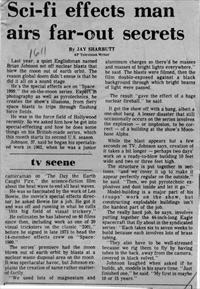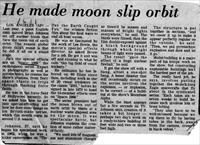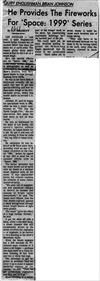Press
Brian Johnson knows how to have a blast
By Jay Sharbutt, AP Television Writer (1 September 1976)
This syndicated article appeared in various US newspapers under titles including "Sci-fi effects man airs far-out secrets" (Star News, Pasadena, 1 September 1976), "Special effects ace- he sets off blasts on a sound stage" (News Press, Santa Barbara, 1 September 1976), "He made moon slip orbit" (Sun Telegram, San Bernardino, 2 September), "Quiet Englishman Brian Johnson: He provides the fireworks for 'Space: 1999' series" (Union, San Diego, 20 September), "He Creates Spectacular Havoc", "It's Tricky Blowing Moon Out of Earth Orbit", "Englishman Gets Bang out of his Job" and "Brian Johnson knows how to have a blast".
LOS ANGELES (AP) - Last year, a quiet Englishman named Brian Johnson set off nuclear blasts that blew the moon out of earth orbit. The reason global doom didn't ensue is that he did it all on a sound stage.
He's the special effects ace on "Space: 1999", the on-the-moon series. Expert in photography as well as pyrotechnics, he creates the show's illusions, from fiery space blasts to trips through flashing force fields.
He was in the force field of Hollywood recently. So we asked him how he got into special-effecting and how he does some things on his British-made series, which this month starts its second U.S. season.
Johnson, 37, said he began his specialized work in 1962, when he was a junior cameraman on "The Day the Earth Caught Fire," the science fiction film about the heat wave to end all heat waves.
He was so fascinated by the work of Les Bowie, the movie's special effects director, he asked Bowie for a job. He got it and was off and running in what he calls "this big field of visual trickery."
He estimates he has laboured on 60 films since then, including work as one of 20 visual tricksters on the classic "2001," before he signed in late 1973 to head the 14-member effects crew on "Space: 1999."
The series' premiere had the moon blown out of earth orbit by blasts at a nuclear waste disposal area on the moon. It was spectacular havoc, but Johnson explains the creation of same rather matter-of-factly.
"We used lots of magnesium and aluminium charges so there'd be masses and masses of bright lights everywhere," he said. The blasts were filmed, then the film double-exposed against a black background through which bright beams of light were passed. The result "gave the effect of a huge nuclear fireball," he said.
It got the show off with a bang, albeit a one-shot bang. A lesser disaster that still occasionally occurs on the series Involves the explosion - or implosion, to be correct - of a building at the show's Moonbase Alpha.
While the blast appears but a few seconds on TV, Johnson says, creation of it takes a bit longer - perhaps two day's work on a ready-to-blow building ten feet wide and two or three feet high.
The structure is put together in sections, "and we cover it up to make It appear perfectly regular on the outside," he said. Then, we put pyrotechnic explosives and dust and let it go.
Model-building is a major part of his troops work on the show. But constructing explodable buildings isn't the hardest part of the job.
The really hard job, he says, involves putting together the 44-inch long Eagle spacecraft that fly about in the syndicated series. "Each takes six to seven weeks to build because each involves lots of brass tubing."
"They also have to be well stressed because we rig them to fly by having tubes in the back, away from the camera, covered in black velvet."
Johnson laughed when asked if he builds, ah, models in his spare time. "Just finished one," he said "My first in maybe 10 or 15 years."
But it isn't a spacecraft of 1999 vintage. It's a radio-controlled model of a Spitfire, Britain's famed World War II fighter.
"I haven't had the chance to fly it yet," Johnson sighed. "Afraid I haven't had the courage to take the first flight."



